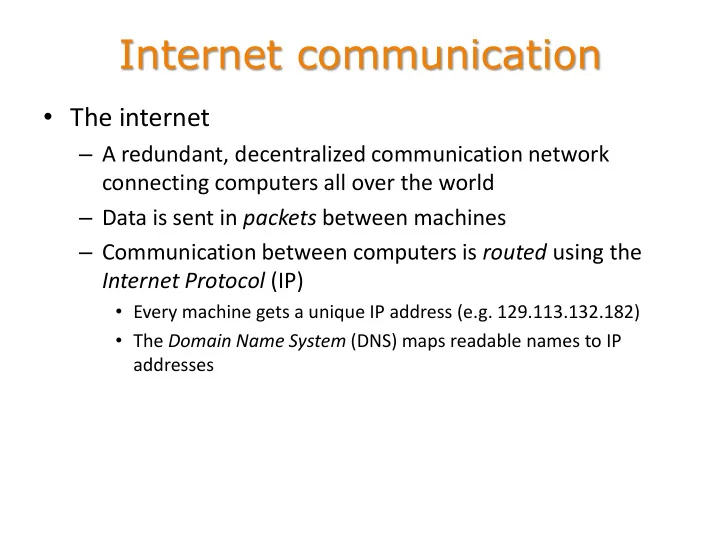

Internet communication • The internet – A redundant, decentralized communication network connecting computers all over the world – Data is sent in packets between machines – Communication between computers is routed using the Internet Protocol (IP) • Every machine gets a unique IP address (e.g. 129.113.132.182) • The Domain Name System (DNS) maps readable names to IP addresses
Internet communication • Connections – The transmission control protocol (TCP) abstracts from packets to connections – A connection between two machines allows back-and- forth communication – Connections are given a port number, so that a single machine can have multiple connections
Client/Server • Clients and servers – Most internet communication is based on a client/server model – The server waits for connections on a certain port – The client initiates a connection to that port
Protocols • Protocol – A set of rules for communication • I hold out my hand towards you, vertically • You grasp my hand • We shake our hands up and down • Etc... • Secure SHell (SSH) – Protocol for terminal based communication – Lots of exchanges of cryptographic information – Packets contain encrypted characters
HTTP and URL • HyperText Transfer Protocol (HTTP) – The dominant protocol for internet applications – Used by clients to retrieve resources from servers – Entirely text-based (simple, easy to read) – Stateless • Each request/response pair is independent from all others • Uniform Resource Locator (URL) – Format for global specification of resources
HTTP request/response HTTP request http://mirin.cs.panam.edu/~etomai/test.txt • Hostname is resolved to IP address (e.g. 129.113.132.218) • Request type is GET or POST Client Server • Request headers give information about the agent • (Additional data may be sent)
HTTP request/response HTTP request http://mirin.cs.panam.edu/~etomai/test.txt HTTP response • If the request specifies a static file • HTML, image, video, text, etc… Client Server • The file is retrieved from the server filesystem • Response headers specify type of data • Using MIME types (e.g. text/html) • The file contents are streamed (printed) back to the client
Recommend
More recommend